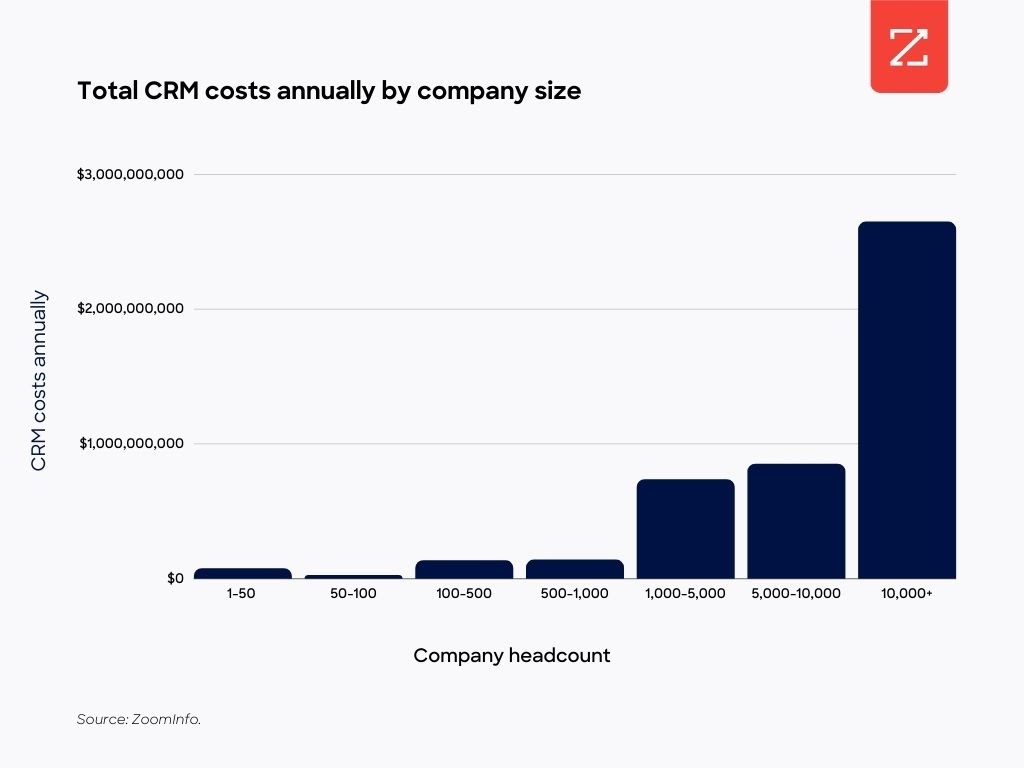Maybe this situation sounds familiar: A company with a sales team of 50 reps decides its data is stale and its customer relationship management (CRM) features don’t meet business needs.
So the company begins defining requirements for new CRM software, and two months later selects a vendor. Then, over the next six months, the system is built out, data is cleaned and migrated, and the new system goes live — all with a price tag of $25,000.
This scenario will be repeated over and over this year across the globe, as companies of all sizes will roll out more than 42,000 new CRM systems and spend an estimated $4.6 billion doing so, according to new analysis from ZoomInfo.
It’s possible, if not likely, that the pandemic lowered installations in 2020. However, Q4 2020 CRM activity was similar to Q4 2019.

By ZoomInfo’s calculations, small firms with less than 100 employees will shoulder the vast majority of CRM implementations — more than 33,000 of them. Each of those projects will cost an average of $3,000.
However, it is companies with more than 1,000 employees that will spend the most on CRM projects, with the average cost being approximately $174,000. The largest companies — those with more than 10,000 employees — will shell out $450,000 on average for their CRM projects.

There are extra costs for bigger firms because large CRM implementations are complex; they include voluminous data migration, more record cleaning, and heavier employee training compared to smaller projects.
Over 10,000 CRM Installations Happen Quarterly
Looking at the past two years of CRM activity captured in its platform, ZoomInfo concluded that, on average, slightly more than 10,000 CRM implementations occur per quarter.

These figures account for a combination of companies installing CRMs for the first time and other organizations switching CRM vendors.
The amount of CRM installations was the basis of ZoomInfo’s $4.6 billion estimate. We took additional information from the platform about the number of CRM technologies in use, and then applied baseline implementation costs published in a calculator created by CRM Switch.
ZoomInfo’s estimate doesn’t include CRM subscription costs or system administrator salaries, which we considered fixed costs that occur annually as opposed to one-time implementation spending.
How Implementations Fit into An Overall CRM Business Ecosystem
CRM implementations contribute to a massive, related ecosystem — in other words, a network of companies all providing services around a product. For example, ecosystems not only include vendors of software, but also consulting firms that help clients manage installations and third-party maintenance providers.
It’s difficult to find a reliable dollar value on the overall CRM ecosystem. However, in a sponsored research report, IDC estimated that Salesforce’s ecosystem will be six times the size of Salesforce itself by 2024, which provides some context to the overall CRM field.
From 2019 through 2024, “Salesforce and its ecosystem are expected to enable the creation of 4.2 million jobs worldwide,” IDC said, adding, “Over the same period, the use of cloud computing by Salesforce customers will add $1.2 trillion in new business revenues to their local economies.”
Salesforce holds about 19.5% market share in the CRM industry, according to prior analysis from Gartner.
By inference, the impetus for the business revenue and job creation noted by IDC comes from implementations of CRM systems.
Data remedies in place of implementations could save money
An interesting question arises as to whether 42,000 CRM implementations are truly necessary each year.
Certainly COVID-19 has presented new challenges that a CRM can solve, such as filling in gaps when face-to-face work meetings aren’t occurring as much with many sales teams working from home. “By configuring a CRM application’s workflows and alerts, the right people will get reminded when a quote needs to be followed up, a service issue is outstanding too long, or when an opportunity gets created,” CRM consultant Gene Marks wrote in Forbes last year.
Beyond the pandemic, a challenge often cited with CRM is the feeling that data becomes stagnant in the system, sometimes leading companies to switch vendors and undertake installations.
However, that dissatisfaction may be unfairly aimed at the CRM itself, according to a new ZoomInfo white paper, “Transforming the CRM From a System of Record to a System of Insight.”
“Most of the frustration encountered by sales and marketing teams has little to do with the functionality of the CRM and everything to do with the state of the data that’s driving the workflows, processes, and motions,” the white paper said.
There are four types of bad CRM data:
Incomplete records.
Outdated or incorrect data.
Information from multiple sources that is not integrated well.
Data that can’t be parsed into actions.
Certain steps, such as data cleansing or integrating real-time data from third-party sources, that could avert some CRM implementations.
As an example, let’s suppose 10% of new CRM projects are prompted by data concerns — a figure that’s likely conservative. If companies could avoid that fraction of implementations in favor of data-based remedies, annual implementation costs generally might decrease by $460 million. Granted, the costs of data cleansing or imports would offset the implementation savings somewhat.
CRM implementations stretch far and cost a lot
Implementation of CRM systems is a multi-billion-dollar expense each year for companies.
With thousands of these projects occurring every quarter, those involved with installations — from vendors to consultants to trainers — contribute to a large CRM ecosystem that flourishes far beyond the software itself.
With the financial stakes so high, proper goal-setting, feature evaluation, and project management are key. Additionally, potential buyers may also want to consider alternative approaches, such as data updates in place of ripping out and replacing an entire CRM system.
